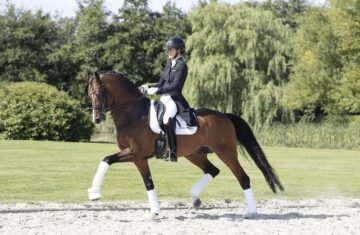The Ultimate Guide to Dressage Horses: Understanding the Art and Science of Dressage
Dressage is often referred to as “ballet on horseback” and represents one of the highest forms of horse training. The purpose of this guide is to delve deeply into the world of dressage horses, exploring their traits, training, and how to find the right one for dressage competitions.
What is a Dressage Horse?
A dressage horse is a breed of horse specifically trained for the equestrian discipline of dressage, where horse and rider work in harmony to perform a series of precise movements, or “figures.” These movements, from basic circles to complex maneuvers like piaffe and passage, showcase the horse’s athleticism, flexibility, and obedience. Dressage horses must possess both physical and mental qualities that allow them to execute these complex tasks with grace and elegance.
Characteristics of a Great Dressage Horse
A successful dressage horse is not just about the breed but also the conformation, temperament, and willingness to work with its rider. Below are some of the most essential characteristics:
Conformation: Dressage horses should have a well-balanced body with strong, straight legs and a powerful hindquarters. The horse’s natural movement should be fluid, with the ability to easily collect and extend its strides. A high-quality dressage horse will have an uphill build, meaning that its withers are higher than its croup, which helps in achieving balance during movements.
Temperament: Dressage requires immense mental focus from the horse. A great dressage horse must have a calm, cooperative temperament, a willingness to learn, and an eagerness to please the rider. Horses that are too nervous or difficult to train may struggle with the demands of advanced dressage.
Movement: Dressage horses need exceptional gaits, with particular emphasis on the walk, trot, and canter. These movements should be elastic and rhythmic. The trot, in particular, should be well-executed with suspension and impulsion, showing the horse’s ability to lift its feet and move gracefully.
Athleticism: Since dressage is a physically demanding discipline, a horse needs to be athletic and possess endurance. The movements in dressage require significant muscle strength and flexibility, particularly in the back and hindquarters, for transitions between collection and extension.
Intelligence and Trainability: An excellent dressage horse must be intelligent and quick to learn. The training process can be rigorous, so a horse that picks up new skills easily will progress more quickly through the levels of dressage.
Best Breeds for Dressage
While many breeds can participate in dressage, certain horse breeds are particularly renowned for excelling in this discipline due to their movement, build, and temperament. Here are a few of the top breeds:
Warmbloods: Warmbloods like the Dutch Warmblood, Hanoverian, and Oldenburg are the most popular choices for dressage. They have the right combination of size, strength, and athleticism to perform at the highest levels. Warmbloods are known for their powerful hindquarters, making them excellent at executing advanced movements like pirouettes and passage.
Andalusians: This Spanish breed is famous for its natural collection abilities, which are essential for upper-level dressage movements. Andalusians tend to be elegant, with expressive movement and a proud carriage, making them ideal for both performance and presentation.
Friesians: With their majestic appearance and striking black coat, Friesians have become increasingly popular in dressage. They possess powerful movement and a natural ability to engage their hindquarters, crucial for the sport.
Thoroughbreds: Though traditionally known for racing, Thoroughbreds can also perform well in dressage. With proper training, they exhibit graceful movement and great stamina, though they may not have the same level of collection as Warmbloods.
Lusitanos: Originally bred for bullfighting, Lusitanos are quick, agile, and have an innate ability to collect. Their natural athleticism makes them highly competitive in dressage.
Dressage Training for Horses
Training a dressage horse is a long-term process that requires patience, consistency, and expertise. Below is an overview of the steps involved in training a horse for dressage:
Foundation Training: The first step is basic groundwork, which includes leading, lunging, and developing trust between the horse and rider. At this stage, the focus is on teaching the horse basic obedience, including responding to voice commands and learning to move freely with balance.
Basic Movements: Once the horse is comfortable with the basics, training progresses to simple dressage movements. This includes learning to move in a straight line, circle, and execute transitions between the walk, trot, and canter. The horse will also be introduced to leg-yielding, which helps develop suppleness and lateral flexibility.
Collection and Extension: As the horse progresses, training will focus on achieving collection, where the horse shifts its weight to its hindquarters, allowing for more controlled, elevated movements. Extension, the opposite of collection, requires the horse to lengthen its stride and cover more ground.
Advanced Movements: At the higher levels of dressage, horses are trained to perform movements like piaffe (a trot performed in place), passage (a slow-motion, elevated trot), and half-passes. These movements require the horse to be highly responsive to subtle aids from the rider and demonstrate extreme agility and strength.
Dressage Competitions and Scoring
Dressage competitions are judged on the precision, rhythm, and quality of the movements performed. Scoring in dressage is based on how well the horse and rider execute a series of required movements, often referred to as “tests.” Each movement is scored on a scale from 0 to 10, with 10 being “excellent.” Judges look for accuracy, fluidity, balance, and the harmony between horse and rider. The goal is to make these difficult movements look effortless.
There are various levels in dressage, from introductory levels for beginner riders and horses to advanced competitions like the Grand Prix, which features the most difficult movements in the sport. Olympic dressage is also one of the most prestigious events in the world of equestrian sports, showcasing the best dressage horses and riders from around the globe.
How to Choose the Right Dressage Horse
Choosing the right dressage horse depends on your level of experience, goals, and budget. If you’re a beginner, it’s often best to choose a horse that has already been trained to a certain level, as it will give you a solid foundation to build on. Here are a few tips:
Evaluate Conformation: Ensure the horse has the proper physical structure for dressage, including a balanced build and strong hindquarters.
Consider Temperament: The horse should have a calm, willing disposition and be eager to work with its rider.
Look at Experience: For intermediate and advanced riders, it’s crucial to consider the horse’s previous dressage training and competition history. A more experienced horse will have an easier time learning advanced movements.
Seek Professional Advice: Consult a dressage trainer or a professional when selecting a horse. Their expertise can help you find a horse that matches your skill level and goals.
Conclusion
The world of dressage horses is as elegant as it is complex. From understanding the qualities of a great dressage horse to mastering the art of training and competition, this discipline requires dedication and passion from both the horse and rider. With the right horse and proper training, dressage can be an incredibly rewarding experience, showcasing the ultimate harmony between horse and human.
Dressage horses for sale Europe
Dressage horses for sale internationally
Horses for sale Czech Republic




